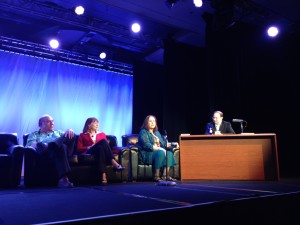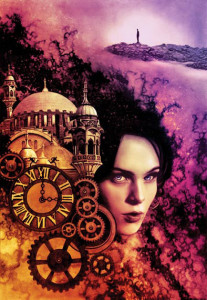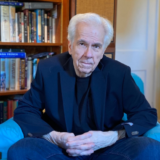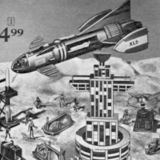
As I was downloading some bid sheets this week, in preparation for packing up the art to be displayed at the LoneStarCon3 Art Show, the 71st World Science Fiction Convention (San Antonio TX) I was suddenly reminded that someone needs to speak up for the Award that matters most to artists in the field: the HUGO for Best Professional Artist. Five terrific artists were on the final ballot this year: Vincent Chong, Julie Dillon, Dan Dos Santos, Chris McGrath, and John Picacio. I have my favorite (but I’m not telling). 🙂
The Hugo Awards are given annually by (and determined by the votes of) members of the World Science Fiction Convention (the “Worldcon”) during a Saturday evening gala that is a focal point of the convention. The event is attended by a majority of the attendees, and awards span several categories. The SF Worldcon is the longest running science fiction convention, founded in 1939 and held 1939 to 1941 and, after the interruption of World War II, every year since 1946. The Hugos, however, named after SF pioneer Hugo Gernsback, did not begin until 1953. Fans always called it that, although it was originally named the Annual Science Fiction Achievement Award. It officially became the Hugo in 1992.
The first year, 1953, was also the only year that separate awards were given for interior and cover artists. Ed Emshwiller and Hannes Bok tied for Best Cover Artist, and the Award for Best Interior Artist went to Virgil Finlay. Then came 1954 . . . and oops! No Art Awards. Seems the awards presented in 1953 were the brainchild of that Worldcon’s committee (the 11th, hosted by Philadelphia), and at that time the conventions were run as independent events. So there was no rule that said Science Fiction Achievement Awards had to be given out in subsequent conventions, or even a set way of awarding them. As a result, it was not until the 1955 Worldcon that the Awards were reinstated, and thereafter became traditional.
Hugo Gernsback, as you should know by now, was the founder of Amazing Stories magazine 🙂 That fact notwithstanding, most fans consider the Hugo the most prestigious of the awards presented annually. I certainly do, perhaps because (DISCLAIMER HERE!) I was once a nominee for one. I was up for one, 2002, for my art book The Art of Richard Powers. But even so, only one of the awards really matters to me – and that is the one for Best Artist 🙂 The most recent winner of this prestigious award, John Picacio put together a wonderful “A Visual History of the Best Professional Artist Hugo Award Winners” – which says it all. I couldn’t have put together a better one, myself.

Hugo for Best Fan Artist
The “Best Professional Artist” award is for artists who work for professional publications; a separate Hugo Award for “Best Fan Artist” was created in 1967 for artists who worked primarily for non- or low-paying fanzines and semiprofessional magazines. As many earlier winners later went on to become professionals in the science fiction art field, this award has long been of interest to art enthusiasts, collectors and historians. One artist, Jack Gaughan (pronounced gawn) even won for Best Pro Artist AND Best Professional Artist in the same year, 1967!
Retro Hugos?
In the mid-1990s the “Retro Hugos” (short for Retrospective Hugo Awards), were added. These are given by Worldcons held 50, 75, or 100 years after a Worldcon where no Hugos had been awarded, which were the conventions in 1939–41, 1946–52, and 1954, and are given for works that would have been eligible in that year, by the same process as the regular Hugos. Retro Hugos have only been given three times: in 1996, 2001, and 2004 for 50 years prior: that is, 1946, 1951, and 1954. Winners were Finlay, Freas, and Bonestell, respectively. While five Worldcons were eligible in 1997–2000 and 2002 they chose not to award them. The next opportunity will be in 2014 for the year 1939, starting the 75-year cycle. If you’re going to be at the upcoming Worldcon, grab a copy of the Retro Hugo Program Book – and you’ll find an article by yours truly on artists working in 1938, who would be eligible for the Best Professional Artist Hugo, 1939. Then you can vote for the artist who would have been your favorite . . . had you been born, in – let’s say – 1920 (because you would have been part of first fandom, right?
“Gone but not Forgotten” Hugo Award. . .
Occasionally there have been Hugos added to the regular line-up of awards which – after a few years – ended up being discontinued. One example was the Hugo for Best Original Artwork. After the Worldcon in 1964, the guidelines for Hugos were changed so that individual conventions could create additional categories as they saw fit – which accordng to current rules allow for one category in any year. These awards are officially designated as Hugos, but aren’t required to be repeated by future conventions. In such fashion, the 1990 Convention chose to award a Hugo for Best Original Art Work . . . which I presume was initiated in an attempt to acknowledge the impact of specific, outstanding works of art as distinct from the contributions of one artist to the entire field. This Hugo was awarded for five of the next six years (it was listed, but not awarded, in 1991), until it was removed from the list of special Hugos, and has not been awarded since. In 1990 and 1992, the winner of both Best Artist and Best Artwork was one and the same: Don Maitz (1990) and Michael Whelan (1992). But in 1993, voters finally got the point and from then on – until 1996 – the winner for Best Artist was NOT the creator of the Best Artwork. Best Professional Artists in those years were Don Maitz (1993), Bob Eggleton (1994), Jim Burns (1995) and Bob Eggleton (1996). Best Original Artwork on the other hand went to James Gurney for Dinotopia (1993), Stephen Hickman for his commemorative stamp booklet Space Fantasy (1994), Brian Froud’s Lady Cottington’s Pressed Fairy Book (1995) and James Gurney’s sequel to Dinotopia: The World Beneath (1996).
It is hard to know why this award was discontinued. Because, to me, it made alot of sense to separate these two things. Then again, alot goes on behind the scenes at Worldcons that only SMOFs know about. Which brings me to:
What’s wrong with this picture? (pun intended)
Many people, over many years, have groused about the Hugos. From the way the voting works (a system I won’t even begin to explain here, however simple or laudable its proponents believe it to be) to the limited size of the voting group (many of those eligible to vote do not). As a consequence, the awards often reflect fan biases and in general are only a good indication of the popularity of the winner. Not that there’s anything intrinsically wrong with being popular – but as the statistics demonstrate, they DO make the outcomes difficult to defend on the basis of sheer talent.
Picacio, who shares with Donato Giancola the frustration of years’ worth of ballot appearances without a win, notes that since 1955, when the Best Professional Artist category was created seventeen pro artists have been recognized with the award in that category (eighteen if you count Leo and Diane Dillon as individuals—debatable because they considered themselves inseparable—even though each was/is a powerhouse individual artist” as John notes on his blog). You do the math. Hundreds of artists in the field, dozens of prospective nominees, five who make to the final ballot. . . and over 57 years, only 17 different artists appearing on the stage to accept that award.
Andrew Porter, long time publisher of the multi-award winning Science Fiction Chronicle (and before that, Starlog) – and equally long time main contender, and twice winner of the coveted Semiprozine Hugo – felt strongly enough about the latter problem, low voter turnout, that he took out front page space in the 1995 Hugo Awards Program Book to publish his Editorial Opinion on “What’s Wrong with the Hugo Voting?” What’s wrong? He wrote:
“. . . problems in categories and definitions are exacerbated by how few people actually vote for the awards. Of 8,000 members of the 1993’s Worldcon, less than 10% actually voted. The weird thing is that the presentation of the Hugo Awards was attended by thousands who applauded their favorites but couldn’t be bothered to fill out and send in the ballot, although it cost them nothing except a few minutes and a postage stamp.”
That was 1995. Now you can forget about hunting for a stamp…..voting is online. But have things improved? Nah. They’ve gotten much worse. I checked the statistics for the number of votes cast for Best Professional Artist from 2000 to 2012. Not only have the number of voting members never even gotten close to the 8000 Porter cited for 1993 (recorded elsewhere as 7,725), but “less than 10% actually voted” in six of those twelve years would more accurately be “less than 5% actually voted”. In only four of those 12 years did the membership exceed 6,000 voting members and as recently as 2012, only 402 of 6197 members cast votes for Best Professional Artist. John Picacio won with 161 of those votes, or 40.5%. In other words, it doesn’t take much to skew the results.
A “popularity contest” not only means the same artists win year after year – it also means that many important artists will be overlooked, or not appropriately honored for their contributions. John Berkey, Paul Lehr, Richards Powers (to name only three) never won a Hugo, and despite heavy lobbying in 2004, this year’s Worldcon Artist Guest of Honor, Darrell K. Sweet, was passed over for a Hugo nomination. Just like Alex Schomburg – who was eventually honored in 1989 with a Special Hugo Award for Lifetime Achievement (accepted for him at the awards ceremony by his granddaughter Susan Schomburg) – it’s a bittersweet “too little, too late” for Darrell . . . who died last year. I’m not the only one to notice these (and other) shortcomings of a now venerable Award. See also Steve Davidson’s Editorial from April 5th, and Arnie Fenner’s “Thoughts on the Best Artist Hugo”.But it doesn’t really matter. We love the Hugos anyway.
And Next week: another major award to know about! The Chesley’s!











Jane,
Great article. Very insightful.
RKT